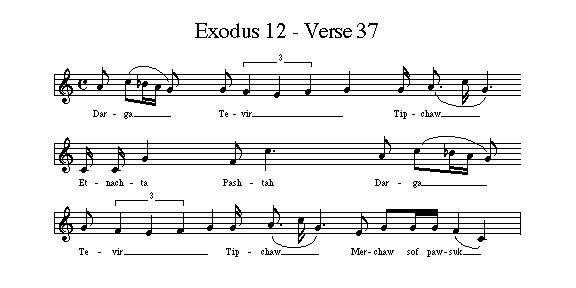
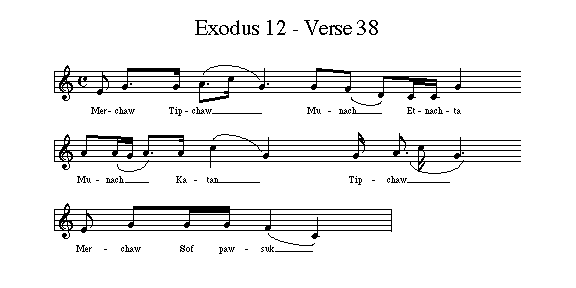
ADOLESCENT RITES OF PASSAGE
by Justin Miera
Quick Reference
Graland/Medieval Knighting- Contemporary Judaic - Aboriginal Australian - Sub-Sahara African - Native American
ADOLESCENT RITES OF PASSAGE
All humans go through major transitions from one set of experiences, perceptions and expectations to another. These passages begin with our birth and move through childhood, adolescence, adulthood, aging and death. We must all meet these physical changes of life. There are many different ways to celebrate the changes according to one's culture and circumstance. As teachers we are familiar with both our student's and our own transformations.
In contemporary education there are a few transitions that we, in the United States of America, regularly mark like elementary, middle and high school graduations. These are obvious, tangible movements surrounded by the traditional trappings of diplomas, gowns and speeches. There are also less acknowledged shifts that affect every child in school. The most powerful is the morphing of a child into an adult through the physiological process of puberty.
Throughout history humans have used adolescence as an opportunity to prepare their young people for the responsibilities of adulthood. Children's bodies change to allow procreation and to accommodate work. Yet, in many ways their minds and spirits are immature, unable to grasp the consequences and possibilities now available to them. Often the preparation for adulthood occurs through religious rites and ceremonies. Parents and communities from around the world take an active role in helping to establish the expectations and responsibilities of their young adults.
This paper will explore the rites of adolescent passage from the musical perspectives of Contemporary Judaic, Aboriginal Australian, Sub-Sahara African, Native American and Medieval European cultures. These activities thread through interdisciplinary curricular activities that provide social, historical and musical contexts for fifth, sixth or seventh grade students.
The purpose of these educational activities is not to usurp the values of a family or community. The purpose is to provide a perspective on how others have guided their youth down a path of self responsibility and self actualization. This program will offer many teachable moments for parents, students and educators and will help review our current activities in adult initiation, or lack there of. The following activities are not meant as a "how to manual" on establishing rites of passage. In fact, most of the activities are surveys, or studies, not the rites themselves. Still, some of these concepts and cultural activities may be difficult to discuss or may provide challenges to a dominant paradigm.
Implications
There is an ethical consideration to this exploration. Some people feel that any discussion of religious notions other than their own is harmful. To coerce any student into participation without their personal agreement, and the agreement of their parents, would violate their freedom not to partake. Even though we, as teachers, may see the lesson as a benefit to greater society, the liberty of an individual can not be arrogated. "It is our first duty to respect the dignity and value of our students and to help them to achieve their status as free, rational, and feeling moral agents" (Strike and Soltis, 1992, p. 90). Still, if a family challenges the appropriateness of this lesson, powerful education will take place. It is not the dissemination of knowledge that defines us as educators, but rather our effectiveness as facilitators to point out the contradictions and challenges of differing perceptions. Simply to engage our communities in a discussion of youth rites of passage would hurry our society to an improvement of responsibility and conscience among everyone.
Another consideration for this process is whether the study of these activities violates any legal obligation public school educators have as agents of the government. The first amendment to our federal constitution states, "Congress shall make no law respecting an establishment of religion." This is often referred to as the establishment clause. This program includes sources from a variety of cultures and religions. It does not take one religion or rite and establish it as the truth. Rather this is a survey of both secular and sacred to give context and perspective to adolescent students. These varied experiences lead to a culminating activity that has no sacred implications, only social insights.
A third consideration is that of religious sanctity. How can we study these rites through musicology, sociology and theology without denigrating their original sacredness? Many world religions do not proselytize or recruit. They keep their religious rites secret and thereby sacred. We, as outside observers, can not presume to know all the purposes and implications of these rites. It is therefore vital that we thoroughly study the small sphere of circumstance that we are preparing to examine. Something as simple to us as a song may actually be a religious vehicle.
For instance, one of the upcoming explorations is of the Lakota Sioux Sun Dance. One person from the Lakota community is chosen to be the Intercessor, or leader, of the dance each year. This person is chosen for their extremely high character and viewed as beyond reproach (Densmore, 1918, p. 102). I would not dare to presume and advertise that I am the person of highest character in my community. Likewise, I would not dare to sing the Intercessor's songs or teach them to others.
Current State
Right now, in the United States of America, there is a conspicuous lack of guidance and an absent communication of expectations for our youth. To find the cause of this breakdown would take a daunting, nearly impossible examination of entangled social dynamics. The antagonists are plentiful for they include everyone of us; teachers, parents, clergy, politicians, businesses. Currently, each one blames the other and very few ever humbly accept their charge as a responsible model for young adults.
The results of this abdication are plentiful as illustrated by Heidi Haugenin in her 1997 paper:
Acts of violence are also more lethal, with 270,000 guns being taken to school each day (Elliott, 1994). The FBI reports that juvenile arrests for violent crimes rose 57 percent nationally between 1983 and 1992 and that currently they are leveling off (Steinhart, 1994). While the highest risk group for initiating violence is teens fifteen to sixteen years old, with the risk dropping dramatically after age twenty, there has been an increase in violent acts by children under the age of fifteen (Elliott, 1994).
All of these examples are extremely disturbing. If they are not, that reaction itself is telling of our social numbness to violence and mayhem. Most members of our society have hardened their hearts to others and buried themselves in self gratification. One way to loosen that fear, selfishness and apathy is by standing as an example of how a "good" adult should behave. A second is to explain the rationale for our actions and beliefs. Finally, we need to provide opportunities and consequences so that young adults can test their growing independent strength. This process seems so simple, yet we have ignored these basic progressions of human growth. Ray Raphael concludes that without rites of passage "The emotional task of adolescence (individuation) and economic function of adolescence (to consume) are buttressed by ideology and cemented into permanent patterns of adult male behavior" (Raphael, 1988, p. 17).
Through this program teachers can begin to rekindle the interest and application of youth mentorship and initiation. Of course, other community members can use aspects of this program, but its initial design focuses on the tools and vehicles currently available to the classroom and music teachers of emerging adolescents. To provide more powerful, relevant connections teachers should use this program as a spring board to build on the regional and cultural rites that exist in their own communities. By drawing upon these community resources we court the support of parents, neighbors and clergy; not alienate them from the process. They will offer even broader examples, rational and opportunities for adolescents.
Implementation
Private and public schools should be able to use these activities. In either setting, some people will not take part, or keep others from the exploration. Because this program deals with sensitive religious and cultural issues it is very important that everyone involved is well informed. The key participants are school, parents and students.
Administrators and teachers are defined as the school. The first objective is to get classroom teachers or social studies specialists, directly associated with fifth, sixth and seventh grade students, interested in the program. When the teaching team is committed and enthusiastic most everyone else will become excited. Next, the principal needs to be approached by the team to be both a resource for ideas and an arbiter with parents. It is always valuable to have an objective participant who can balance the ideals and emotions of a circumstance.
The first communication with parents is enthusiastic. It offers opportunities for them to interact with their children and to participate in the process. Included in the Appendix is a sample letter sent to Graland Country Day School parents during the 1997 school year. Further explanation of the letter follows in the "Knighting" section. Because the musical pull-out to this program is new it was not mentioned in the letter. A sentence should be included that reads: "During music time students will explore Medieval music and the music associated with other rites of passage from around the world." Note that the letter does not specifically offer students an out. If parents have problems it should be handled on an individual basis.
The academic focal point of this program is a classroom study of Medieval European history. Historical exploration into the areas of literature, arts, politics, business and service flow from the process of knighthood. This conceptual activity has been used with fifth grade students at Graland County Day School in Denver, Colorado since 1953. Mrs. Priest began the program. Dorothy Herrington and Sally Kennedy were the two fifth grade team teachers directing the process during the 1997-98 school year. This was the first year that the included musical activities were used.
There are various projects that lead up to the knighting ceremony. For literature, students read the Newberry honor book "Catherine, Called Birdy" by Karen Cushman, published by Trophy Newberry. The story relates the life of a young woman in 1290 England through her diary. It uses authentic language, cultural descriptions and historical perspectives to describe a fourteen year-old whose father is determined to marry her off. Marrying is a powerful rite of passage for many adolescents, historically and today.
Students take six weeks to prepare for their ceremony through the visual arts. During wood shop they make swords. In the classroom students study heraldry to design and paint their own shields. In art they work on stained glass and wizard sculptures.
The most substantial textbook used in the classroom is "Early Times, The Story of the Middle Ages" by Suzanne Strauss Art, from Wayside Publishing, Concord, MA. Six out of fifteen chapters are used for focused study. They are a) The Power of the Christian Church, b) The Feudal System, c) Knighthood, d) The Crusades, e) A Day In the Life of a Lord and f) Towns and Trade. Each chapter contains interrelated facts and anecdotes about the individuals and society of that time. Each chapter concludes with a series of questions, ideas for consideration and possible projects.
One of the most powerful parts of this study is the process of moving from page to squire and then knight. In Medieval times a boy of noble birth would go into
service as a page at the age of seven. This would take place with a friend or family member who would teach them the polite arts of music and dancing. The child would also have limited responsibilities like carrying messages, setting tables and lighting candles. At the age of fourteen a page would become squire, in service to a knight. This would be an apprenticeship into the specifics of warfare and horsemanship. The squire would polish and care for armor, spurs and weapons. In battle he would carry the armor and weapons, and care for his wounded knight. At the age of twenty the squire moved into knighthood with elaborate ceremony and was given the gifts of armor, weapons and a horse (Art, 1995, pp. 87-88).
Our student's knighting process is open for both boys and girls. It condenses the seven years of paging into seven days, and likewise, squiring into one week. There are ceremonies for both the transitions from page to squire and from squire to knight. The Appendix contains copies of handouts detailing the ideals, criteria and duties of both pages and squires. Herrington and Kennedy created these for use in the 1997-98 school year. Note the publicly displayed check list for home duties and schedule for school duties.
This is a description written by Herrington and Kennedy detailing the "Becoming a Page" ceremony:
a) Kennedy teaches square knot and discusses silence and expectations while Herrington sets up room, b) File in alphabetical order, single file, in silence, make two semi-circles, c) Herrington lights candles, d) "Will the first row please step forward one pace," e) "Take this rope and join it together as a symbol of you commitment to your own private journey to knighthood. You will not tie your own necklace. Turn to your right and tie on the person's in front of you. Speak not!" f) "Raise your right hand: I solemnly embark upon the duties of paging. To that end, I shall 1.) serve the head of your castle with honor and respect 2.) perform any task that is asked of me with good cheer and a commitment to excellence 3.) and last of all, I shall engage in my studies with vigor and joy."
This is the written description by Herrington and Kennedy on the "Becoming a Squire" ceremony:
You have accomplished the duties of a page. For seven years you have toiled in your lord's castles, listening to stories, tilting on the training field. The time has come to increase your responsibilities. You will sharpen your skills with sword and lance; you will know the battle field; you must find your way through the fog of war. Raise your right hand: I solemnly embark upon the duties of squiring. To that end, for the next 7 days I shall continue to 1.) serve the head of my castle with honor and respect 2.) perform any task that is asked of me with good cheer and a commitment to excellence 3.) and last of all, I shall engage in my studies with vigor and joy.
At the writing of this paper specific details about the final knighting ceremony were not available. Following the ceremony there was a feast to mark the celebration of passage. At the feast the King and Queen, a pair of the previous year's knights, make requests of various students. One of the requests during the 1997-98 festivities was for each class to sing their Gregorian chant.
Music Application of Medieval Rites
The students spend the three weeks leading up to the ceremony studying the theory and history of Gregorian chants and Medieval music. The culminating activity for each class is to write an original, authentic chant using lyrics related to their school, home or knighting experiences. One requirement for writing the melody was to use step-wise movement of the dorian mode This is the same as starting and ending on Re, the second scale degree. There has to be at least two stanzas, or sentences of lyrics. The rhythm needs to use a steady pulse with a longer, sustained beat at the cadence, or end of each line.
Students in each class take turns suggesting melodic movement and lyric content. Everyone has an opportunity to participate in generating ideas. The students review and change both lyrics and melody. The students selectively delete inappropriate, unpleasant and unmanageable segments to create a concise, powerful piece of music. Students rehearse their piece in music class to create a true monophonic chant sound. A student leader(s) from each class is chosen to direct the chant at the festivities.
The knighting lesson is a deeply integrated and interdisciplinary experience. All students find ways to apply the concepts established in the classroom whether it is through reading literature, manipulating art materials, singing songs, reciting oaths or participating in service. To broaden the musical and social aspects of adolescent rites we will now access the four other cultures: Contemporary Judaic, Aboriginal Australian, Sub-Sahara African and Native American.
In Judaism there is a long-standing rite of passage for both genders. For boys it is called bar mitzvah and for girls bat mitzvah. In actuality, these are not events or ceremonies, but rather an acknowledgment that a boy or girl is "old enough to be responsible for mitzvot. Mitzvot are the commandments that a Jew does in order to not only live a Jewish life, but also to sanctify life" (Salkin, 1992, p. 3). The age of this responsibility is thirteen plus one day. Thirteen is thought of as the age of spiritual and moral choices because both good and evil inclinations begin to battle in the psyche. Parents must also take responsibility for having introduced and taught the commandments (pp. 4-5).
There are several activities acknowledging bar and bat mitzvah. One is to cantillate, chant, the papshah, or Torah passage for the week of the child's birthday. There is also the cantillation of a haftarah, another liturgical text. Other activities demonstrate the covenant by performing mitzot, or positive actions. Mitzot includes: a) gemilut chasadim, acts of loving-kindness, b) tzedakah, sacred giving, c) Talmud Torah, the study of Torah, d) hidur penei zakein, honoring the elderly, e) zicharon, memory f) Shabbat, honoring the Sabbath, g) kedushat halashon, the sanctity of speech, h) kedushat hazeman, the holiness of festivals and sacred seasons, i) tzar baalei chayim, non-cruelty to animals, and j) tikkun hanefesh, repairing the self (pp. 43-52).
Music Application of Contemporary Judaism
Cantillation is a way of chanting used for the recital of prayers and scriptures (Nulman, 1975, p. 43). There is a four step process used to teach cantillation to the boys and girls for bar and bat mitzvah. The first step is to read the sentence in Hebrew. Second, one must identify and read the trope, or musical signs. Third, sing the trope. Finally, sing the Hebrew sentence with the tropic application. The cantor essentially layers two different concepts: the text and the music.
The trope is a symbol that relates a musical motive (p. 252). There are many tropes. They have varying degrees of difficulty and occur with different frequency. The tropes are strung together to create a phrase. Most tropes have a specific melody, but some are contextual and derive their interpretation by the following trope or two. The tropes are concretely set to liturgical passages and can not be read out of context. There is a word defining each trope. It is that word that is read, then sung, during the second and third steps of Cantillation education.
The students will read a historical passage from the Torah so as not to imply religious indoctrination. All history can be academically debated and thereby provide teaching opportunities. The passage comes from Exodus 12, verses 37 and 38. Hebrew is not easily translated into English and the tropic cantillation is impossible to translate. Therefor, all musical examples are in Hebrew. Here is the English translation of the text:
37] The Israelites journeyed from Raamses to Succoth, about six hundred thousand men on foot, aside from children. 38] Moreover, a mixed multitude went up with them, and very much livestock, both flocks and herds.
This is the phonetic pronunciation of the Hebrew text with the tropic symbols:
37] Va-yisu v'nei-Yisrael mei-raseim sukota k'sheish-mei-ot eilef ragli havarim l'vad mitaf. 38] V'gam-erev rav alah itam v'tzon uvakar mik'neh kaveid m'od.
Again, the first step is to read the words. The second is to read the trope. here are the trope words that correlate to the above symbols:
37] dargaw tevir tipchaw etnachta pashtaw dargaw tevir tipchaw merchaw sof pawsuk 38] merchaw tipchaw munach etnachta munach katan tipchaw merchaw sof pawsuk


Note that verse 37 is divided into two, five trope modes with the first three tropes of each being identical. Note the similar cadence of "merchaw sofpawsuk" in both 37 and 38. Sequentially singing these tropes is the third step. Munach is one of the contextually changing tropes. The key is variable depending on the register of the singer.
The final step is to sing the Torah passages:
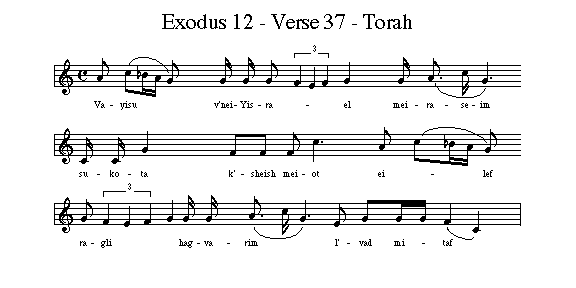
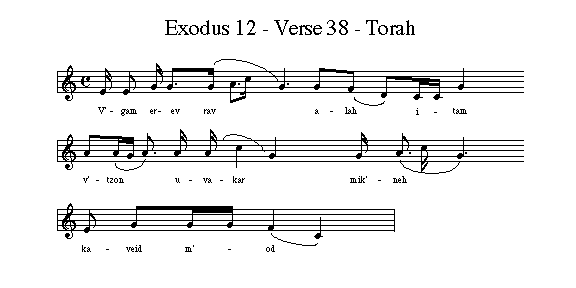
All of the pronunciation and performances were given by Regina Heit, cantor at Temple Emanuel, Denver, Colorado, on August 5, 1998. All non-attributed information on Hebrew and cantillation is also from Mrs. Heit.
This musical demonstration of bar and bat mitzvah clearly illustrates the adolescent's comprehension of and participation in their society, culture and religion. The four step process demands dedication and provides a concrete exhibition of their responsibility for mitzvot
In the Aboriginal cultures of Australia there is a period of learning and testing for children starting at age twelve. This time is called the Burr-Nong and does not end for an individual until they have passed all the tests. This usually lasts until the boys and girls are between sixteen and eighteen years old. Once passed they are considered adults. Men exclusively teach the boys, and women the girls, about tribal secrets, adult responsibilities, character values and interdependence. In fact, part of the testing is qualified by the assistance each child gives to another (Nunukul, 1972, p.71). This sharing and egalitarian value exist throughout the society with common property, equal treatment under the law and no hierarchy of importance (Mathews, 1979, p. 23).
Learning the stories and legends are of primary concern during the Burr-Nong process. The Aborigines believe that all things flow from one source and they call that spring dreamtime. Dreamtime stories tell about the creation, maturation and progression of our world. These stories are therefor sacred and told in ceremonial circumstances.
Each tribal group has variations on the rites and symbols of the Burr-Nong. There are differences in the symbols used for ritual scarification. These demonstrate tolerance to pain in the harsh, unforgiving land. Lessons are taught in perfectly round rings of raised earth connected by raised pathways. Some groups use two rings, others three. As the adolescents progress in their learning and testing they move from one ring to the next. One final test for the boys is to usurp the old men to make room for the new. The literal manifestation of this takes place over the final ring. The elders sit on a platform fastened to the upturned roots of a wattle tree. The young men then rock and shake the platform until the elders fall to the ground (Nunukul, 1972, pp. 71-72).
There is also a musical example of gender initiation segregation. Bullroarers are a small thin piece of tapered wood. They are strung at one end with about four meters of chord. As it swings around the head the bullroarer creates a humming sound and is used in various ceremonies. No women or uninitiated boys may hear the bullroarer and punishment could be death (Mathews, 1979, p. 28).
Music Application of Aboriginal Rites
Music students are exposed to Aboriginal music through the dreamtime stories and music. As stated earlier, dreamtime stories are usually told in ceremony. Describe the significance of the ceremony, but clarify that we are simply engaging in a fun activity. Didgeridoo and click sticks accompany the sung stories. Didgeridoos are hollowed out eucalyptus tree limbs about a meter in length. They are performed, like brass instruments, by buzzing one's lips into the hollow tube. Humming and redirecting the airflow create additional sounds. Accomplished Didgeridoo players can circular breath. This is done by breathing in through one's nose while blowing out through the mouth. The performer's cheeks act as billows, like with bagpipes. Click sticks are small, solid wood sticks about eight inches in length and an inch in diameter. They are struck together in a steady, single beat pattern. Striking boomerangs together creates the same sound.
A soloist usually sings the action of the story in short, melodic phrases. In between each phrase segment of the story the chorus, group, responds with a repeated refrain. There is very little melodic movement which focuses greater attention on the words of the story, much like the Gregorian chants of Medieval Europe.
The students superficially replicate this activity by using all these elements. First introduce the didgeridoo. Pseudo didgeridoos are easily made with a meter of one inch PVC pipe, found at any hardware store. Acquire four of these didgeridoos and sand the openings to prevent splinters and cuts. Clean the pseudo didgeridoos between students. Dip the end of the tube into a bleach and water solution of one drop bleach to 16 ounces of water. Tall, hard plastic cups work well as a container for this. Dry the didgeridoo with a paper towel and pass it on. Try to have the students sustain at least four count patterns with their tones.
Second, music classroom rhythm sticks or claves easily replicate click sticks. Again the steady pattern for click sticks is a repeated, single (quarter note) beat.
Students will compose their own creation story, or use one that already exists, as the lyrical basis of their song. This leaves open the freedom for anyone to express their own beliefs, barrow stories and ideas, or just be silly. One individual can tell their whole story, or a small group of students can write out parts and take consecutive turns as soloists. Divide the class into three groups: didgeridoos, click sticks and singers. Rotate the groups two more times so that everyone has an opportunity at each station.
The melody is adapted from the "Tjilpa Song of the Ilbalintja Plain" (Ellis, 1964, p. 114). This is a dreamtime story used during the inkura festival. Three different totems, or clans, gather at this festival for the last initiation rites of their young men. The original story describes the travels of the Tjilpa horde moving from one location to another. Again, the students will use the melody, but make up their own story action. Because the story's phrases my vary allow the students to modify the soloist's rhythm. Note that the solo has only two pitches and the chorus is essentially chanting a response.
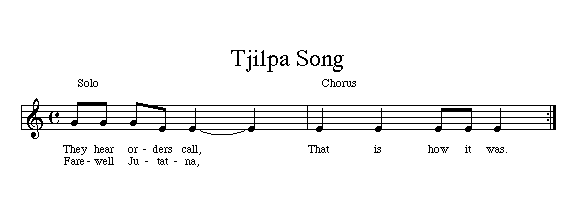
The Burr-Nong of Australia holds purpose for aspiring young adults. The recitation of dreamtime stories provides cultural contexts, historical perspectives and moral expectations. The shaking of the platform establishes membership in the adult community. The emphasis on collaboration helps to perpetuate community interdependence.
In Ghana, Africa the Akan people use music as an entertainment medium, and as a vehicle of social expression. Some songs are used for games, dancing or passing time. Many "reveal the importance of being an active, aware, and responsible part of society" (Adzenyah, 1996, p. 11). The Akan find relevant lessons on how to live a good life through their music. They also learn the consequences for harmful behavior.
The following song, "Meda Wawa Ase" (p. 89) is a secular account of a person who has not fulfilled his obligations to society. In the song he:
...finds himself surrounded by his enemies-those who would lead him astray, and those who would observe his actions and judge him critically. A song of this type might be sung as a warning to young people that if they are not observant of the mores of their society they will create a situation for themselves that could lead to ostracism and shame, isolation and unhappiness (p. 90).
The person in this song describes being under the wawa tree, separated from society. This is a great opportunity for a class discussion to define inappropriate behavior, consequences for one's actions and the power of social isolation. The first question to ask the class is: "What behaviors, in any society, are harmful?" The next question is: "How would those behaviors be punished in the Akan, our, or another society?" Finally, students discuss the word ostracism and why isolation is so powerful. In the Akan society a person may be banned from the group for varying periods of time. In our society we have prisons. The students compare the effectiveness of each.
We, the teachers, pose these questions to elicit exploration in a focused area. When students use their own examples then problem solving becomes relevant. This is one aspect of constructivist teaching. Constructivism is helping students to construct an understanding of the world in which they live. This requires that students have "opportunities to ponder the question, form their own responses, and accept the risk of sharing their thoughts with others" (Brooks, 1993, p. 38). Meda Wawa Ase focuses the exploration on adult responsibilities and the consequences of inappropriate choices.
Music Application of African Culture
Meda Wawa Ase is originally a vocal piece. Singing is a large part of the general music classroom, but there are always some students who are uncomfortable with their voices. For that reason we will add traditional percussion to accompany the song. Chernoff states that "perhaps the most fundamental aesthetic in Africa (is) that without participation there is no meaning" (as quoted in Adzenyah, p. 13). All students must still sing, and all will find success in the activity.
These four rhythms were originally notated for hand clapping in "Let Your Voice Be Heard!" We will apply each rhythm to a different percussion instrument and this will add more excitement and variety to the ensemble. For the first rhythm use shakers or maracas. The Shona, Zimbabwe equivalent is called a hosho (p. 128). For the second rhythm use cowbells. For the third rhythm use hand drums. For the fourth rhythm use sticks or woodblocks.
Have the class equally divide themselves by the five parts. Practice each of the parts separately. Successively add the four percussion parts together. Finally, once the rhythm is established, have the fifth group sing the song. Rotate the groups after each performance so that everyone participates on each instrument. If the ensemble is having difficulty with five parts then use fewer percussion rhythms.
Listening is the key to a good ensemble. Teach the melody and percussion parts by rote so that the students depend on each other, not the written music, to guide the performance.
Learning in this manner requires intense concentration, memory development, and a willingness for the student to take an active role in the learning process...The sense of being partners in the creative process often creates strong bonds between teacher and student (p. 140).
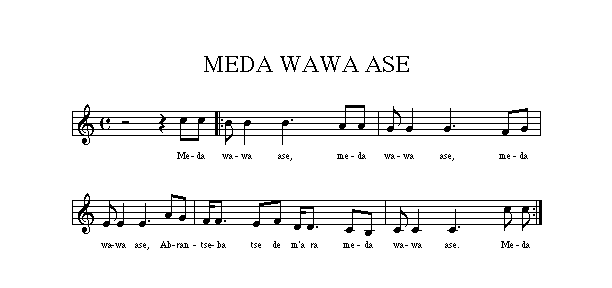
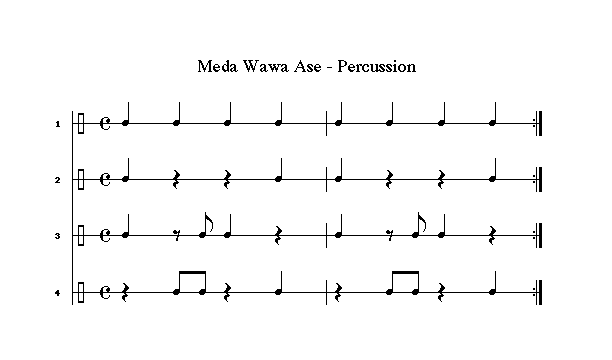
Rather than punishing bad behavior, the Teton Sioux reward their virtuous adolescents. During the summer months there is a powerful event called the Sun Dance. The exact purposes, symbols and songs for the Sun Dance vary between different tribes or nations (Densmore, 1992, p. 87). In general, the Sun Dance is an opportunity for adult males to offer themselves in sacrifice to the creator, Wakan'tanka (p.85). The oblation and vow are highly individual. It usually takes the form of endurance dancing, traditionally for four days, and sometimes culminates in a flesh offering. This offering could be scarification of the arms or chest, or even suspension from the sacred pole in the center of the dance grounds (pp. 88-91).
Every activity leading up to the Sun Dance is very specific and meaningful. From the placement of tents to the use of sage, the colors of paint to the acknowledgment of directions; it is an intricate recipe with each ingredient holding significance. The leading men, or chiefs, spend the days leading up to the dance electing people to various roles. The key roles are that of the Intercessor, the Leader of the Dancers, the four young men who select the tree for the sacred pole and the four young women who cut it down. All of these participants are chosen because of their outstanding character. For those chosen as the Intercessor and Leader of the Dancers "... the qualifications were so well known that a man who lacked them would not presume to seek the position. He must have a reputation above reproach... (p. 102)" The four young men were to be unmarried and the four young women virgins, all of "unquestioned integrity" (p. 103).
Music Application of Native American Rites
The Intercessor leads most of the songs and ceremonies on the days preceding and during the dance. Some songs are communal such as the one sung after the four young men have selected the tree. Everyone is invited to attend the tree cutting. After the tree has fallen everyone sing the following song. The lyrics relate to warriors who take vows for the Sun Dance. They do it in thanksgiving for deliverance from danger.
The accompaniment for the song is played on frame drums. The rhythm is steady, unaccented quarter notes. At the conclusion of the song play a short, fast roll. The tempo for both voice and drum is quarter note equals 80 beats per minute. Sleigh bells are used to mark changes in meter. They are traditionally tied to the legs of dancers to help accent the beat. We will use them to establish the down beat of each measure. During 2/4 measures the bells play quarter note, rest. During 3/4 measures the bells play quarter note, rest, rest.
The vocal line has several unique characteristics. The lyrics "hey" and "yo" are used to mark the melodic movement and have no meaning. Many measures begin with a fast sixteenth note. The sixth scale degree is flatted twice during the song. Each of these musical features provides great content for music education.
Divide the group into the three parts: vocals, drums and bells. First, establish the basic beat on the drum. Next, add the sleigh bells playing quarter note, rest. Finally, add the vocals. After the performance rotate the three stations.
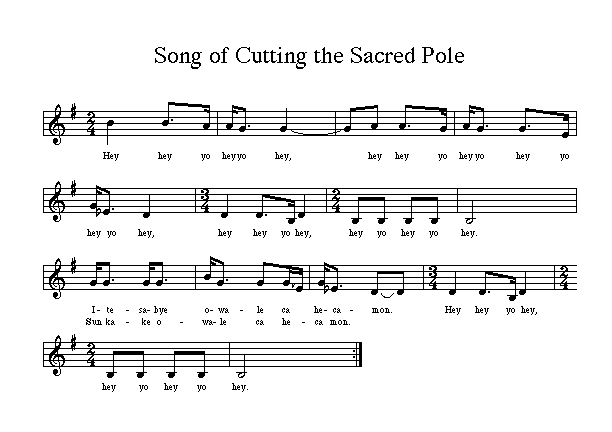
Conclusion
It is natural to feel alone during a major transition. Especially one that affects all the physical, mental, emotional and spiritual aspects of our life. The transition through adolescence is universally difficult. In our contemporary United States society it is arguably more difficult. Many adults are too preoccupied with work and self indulgent distractions to act as mentors and guides for adolescents. As a result our society is plagued with teenagers disconnected from their community and the role they play in it.
In other cultures adolescence is an important time because it establishes boundaries and expectations for the new adult community. To emphasize this significance there are rites and ceremonies to mark the transition. Some rites take the form of liturgical participation in worship. Jewish children cantolate the papshah and haftarah in synagogue. In Aboriginal Australia there is liturgical singing as well as education into historical and religious heritage. The Akan of Ghana warn their young people about the consequences of inappropriate behavior. The Lakota Sioux of North America reward their young people of high moral character. In medieval Europe there was a specific system to establish knighthood: page, squire, knight.
All of these examples offer powerful opportunities to connect with burgeoning adolescents. Everyone from these societies participates in the establishment of expectations and takes full responsibility to demonstrate acceptable adult behavior. We can learn from these other people how to exhibit and explain the values and expectations of our society. To achieve participation from parents and community members we teachers bear a terrific challenge to educate them on the merits of this program. Ultimately, whether they participate or not, any discussion helps to improve communication between adults and teens. When confusion and difficulties are brought out in the light, truth and righteousness become clear. This is not the only way to the truth, but this program of activities is meant to spur inquiry in our students and ourselves.
Bibliography
Adzenyah, Abraham K., Maraire, Dumisani, & Tucker Judith C. (1997). Let Your Voice Be Heard!; Songs from Ghana and Zimbabwe. Danbury, CT: World Music Press.
Art, Suzanne Strauss (1995). Early Times, the Story of the Middle Ages. Wayside Publishing.
Brooks, Jacqueline G. & Brooks, Martin G. (1993) In Search of Understanding: The Case for Constructivist Classrooms. Alexandria, VA: ASCD.
Citizens Budget Commission (1997). The State of Municipal Services in the 1990s Social Services in New York City. In Electronic Policy Network [Online]. Available: http://epn.org/cbc/socserv2.html
Cushman, Karen (1994). Catherine, Called Birdy. NY, NY: Harper Trophy.
Densmore, Frances (1992). Teton Souix Music. Lincoln Nebraska: Bison Book.
Ellis, Catherine J. (1964). Aboriginal Music Making; A Study of Central Australian Music. Adelaide: Libraries Board of South Australia
Haugen, Heidi L. (1997). Prevention of Youth Violence; A Resource Guide for Youth Development and Family Life Professionals and Volunteers. In Cornell Cooperative Extension [Online]. Available: http://www.nnfr.org/nnfr/Youth_Violence.html [1998, April 2].
Mathews, Janet (1997). Wurley & Wommera: Aboriginal Life and Craft. Clevland and New York: William Collins Publishers.
Nulman, Macy (1975). Concise Encyclopedia Of Jewish Music. NY, NY: McGraw- Hill.
Nunukul, Oodgeroo (1972). Dreamtime. Australia: Angus & Robertson.
Raphael, Ray (1988). The Men From The Boys: Rites of Passage in Male America. University of Nebraska Press.
Salkin, Rabbi Jeffrey K. (1992). Putting God On The Guest List: How To Reclaim The Spiritual Meaning of Your Child's Bar or Bat Mitzvah. Woodstock, VT: Jewish Lights Publishing.
Strike, Kenneth A. and Soltis, Jonas F. (1992). The Ethics of Teaching. NY, NY: Teachers College Press.
A final paper presented in partial fulfillment of the course Multicultural and Ethical Perspectives in Education MLS 654 H Course Consultant is Pam Newman, Ph.D. REGIS UNIVERSITY August 5, 1998